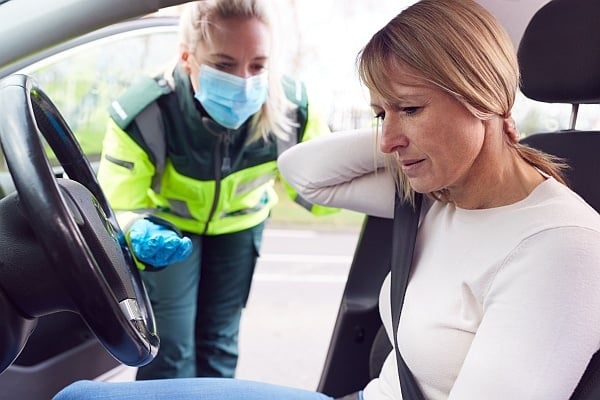- Attorney, Business
Uber and Lyft Drivers are Independent Contractors
If you’re in a car accident with an Uber or Lyft driver, suing the ride-share company directly is probably not an option. This is because Uber and Lyft drivers are not employed by Uber or Lyft. Instead, the companies treat them as independent contractors.
In general, while employers can be vicariously liable for the actions of their employees, companies are not responsible for the wrongful or negligent actions of their independent contractors. The argument here is that, while Uber and Lyft provide their drivers with a smartphone application to help locate passengers, the drivers use their own vehicles and set their own schedules, work conditions, etc.
Because ride-share drivers are independent contractors, ride-share companies like Uber and Lyft have limited legal liability when it comes to their drivers’ actions, so you’ll have a tough time suing Uber or Lyft after a car accident. But that doesn’t mean these companies can’t be held financially responsible (through their insurance coverage) for injuries and other damages after a crash involving one of their drivers.
Uber, Lyft, and Car Insurance Considerations
Ride-share companies require all of their drivers to have their own car insurance coverage, and both companies will supplement that insurance and provide additional coverage for accidents when the driver is available for a fare via the app, or is actively transporting a ride-share passenger. Having Uber or Lyft insurance in the picture is particularly important because most personal insurance carriers will deny or disclaim coverage if the accident occurred while the insured person was “driving for hire” using the covered vehicle. In some states, however, drivers can purchase ride-sharing endorsements for their personal policies, which will step up in the event of a claim by a passenger.
It’s important to understand the predicament that ride-sharing drivers are in with respect to insurance. As explained, unless the driver has an endorsement, the driver’s personal policy won’t cover. The insurance provided by Uber and Lyft requires the driver’s own policy to be used first; if the carrier denies the claim, then the Lyft or Uber policy will cover. But when the driver submits the claim to his own company, if he does not have an endorsement, his own carrier can cancel his policy, on the grounds that he has committed fraud (the terms of his insurance contract provide that he’ll use the car for personal use only). So, the upshot is that the injured passenger might get coverage for his injuries…but the driver might find himself dropped by his carrier.
You can read more about insurance considerations in What Do Uber and Lyft Drivers Need to Know About Car Insurance?
When Ride-Sharing Companies Provide Coverage
In general, ride-share companies follow a four-tiered approach when it comes to insurance coverage for drivers:
Period 0. Here, the driver does not have the app on at all (the driver isn’t in “driver mode”). Drivers’ personal policies will apply to any accidents; the Lyft or Uber policies do not apply.
Period 1. The driver has the app on and is cruising around, waiting for a match. If the driver causes an accident, she must refer the injured person’s claim first to her own carrier. If the carrier rejects the claim, the Uber or Lyft policy will cover. (Relief for the injured person, but perilous for the driver, as explained above.)
Period 2. The driver has accepted a match and is driving to the pick-up location. The claim must be handled in the same manner as in Period 1, above.
Period 3. The driver is transporting a rider. The period ends at drop-off. Here, too, the two-step explained above applies (submit the claim first to the driver’s company, then if it’s rejected, the Lyft or Uber policy will cover). But in addition, here the Lyft/Uber policies will apply to damage to the driver’s car (though again, the driver must look first to her own policy, with the attendant risk that she’ll lose her insurance). The policy limits of the coverage are quite small (limited to the car’s actual cash value, and a hefty deductible of $1,000 to 2,500). Both companies also offer uninsured motorists’ insurance.
What Damages Can I Recover?
As with any car accident, if you are successful in your claim, you will be entitled to compensation for both your economic (or “special”) and non-economic (or “general”) damages.
Your economic damages will include any monetary losses you suffered as a result of the accident, such as the cost to replace or repair any damaged property, payment of past and future medical expenses, and compensation for past and future lost wages related to your accident injuries. Your non-economic damages will include compensation for pain and suffering, emotional distress, loss of consortium, and loss of enjoyment of life.
Learn more about what your car accident claim is worth
Get the compensation you deserve. We’ve helped 285 clients find attorneys today.
Please answer a few questions to help us match you with attorneys in your area.
In many cities, Uber and Lyft are wildly popular alternatives to traditional taxi services. These companies employ drivers who work as independent contractors and who use their personal cars to transport fares that are arranged through smartphone applications. Passengers request a pick-up, and the application matches an available driver, who retrieves the passengers for a quoted fare and delivers them to the desired destination. The app handles billing and payment, relieving the driver from asking for payment and the passenger from paying on the spot.
Along with the novelty of the rideshare concept comes novel issues related to liability for a car accident involving an Uber or Lyft vehicle. Whose insurance will apply to injuries and other losses stemming from the accident? Can you file a lawsuit directly against Uber or Lyft after a crash involving one of their drivers? In this article, we’ll answer these questions and a few more








